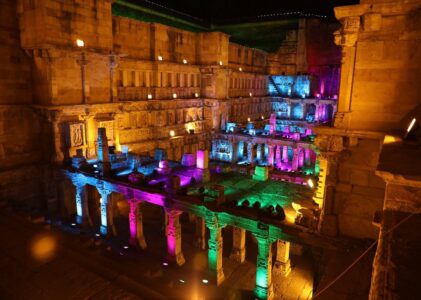Introduction
Rani Ki Vav, located in Patan, Gujarat, is one of the most remarkable stepwells in India, celebrated for its intricate architecture and historical significance. Built during the 11th century by Rani Udayamati in memory of her husband, King Bhimdev I, this UNESCO World Heritage Site showcases the ingenuity of Indian craftsmanship and engineering. With its stunning sculptures, elaborate carvings, and unique design, Rani Ki Vav is not only a source of fascination for historians and architects but also a symbol of the rich cultural heritage of Gujarat. This comprehensive guide explores the history, architectural features, cultural significance, and practical information for visiting Rani Ki Vav.
Historical Background
Origins of Rani Ki Vav
Rani Ki Vav was constructed in the mid-11th century during the rule of the Solanki dynasty. The stepwell was built as a tribute by Queen Udayamati to her late husband, King Bhimdev I, highlighting the royal patronage of architecture in ancient India. It reflects the socio-economic conditions of the time and the importance of water conservation.
The Solanki Dynasty
The Solanki dynasty, known for its contributions to art and architecture, played a significant role in the development of Gujarat during the medieval period. Rani Ki Vav stands as a testament to their architectural prowess and dedication to public welfare.
Historical Significance
Over the centuries, Rani Ki Vav has witnessed historical events, including the decline of the Solanki dynasty and the subsequent rise of other powers in the region. Its architectural style influenced the construction of stepwells and water storage systems across India.

Architectural Marvel
Overview of Design
Rani Ki Vav is an inverted temple and is designed as a multi-storied stepwell, with intricate carvings and sculptures adorning its walls. The stepwell descends deep into the ground, featuring a series of platforms and steps.
Key Features
Entrance and Structure
The entrance of Rani Ki Vav is grand, adorned with detailed carvings and motifs. The stepwell has seven levels, with each level showcasing exquisite sculptures of gods, goddesses, and mythical creatures.
Sculptural Details
The walls of Rani Ki Vav are decorated with over 800 exquisite sculptures, showcasing intricate craftsmanship. Some notable sculptures include:
- Dancing Women: Elegant representations of women in various poses.
- Deities: Idols of Hindu deities, including Vishnu, Shiva, and Durga.
- Mythical Figures: Intricate carvings of celestial beings and mythological scenes.
Symbolism
The architectural design of Rani Ki Vav is symbolic of the cosmic ocean, where the stepwell serves as a connection between the earthly realm and the divine. The sculptures depict the belief system and cultural values of the time.
Cultural Significance
Rani Ki Vav as a Heritage Site
Recognized as a UNESCO World Heritage Site in 2014, Rani Ki Vav is celebrated for its historical and architectural significance. It attracts scholars, historians, and tourists from around the world, contributing to cultural tourism in Gujarat.
Festivals and Celebrations
Rani Ki Vav hosts various cultural events and festivals, promoting traditional arts and crafts. These events attract local artisans and visitors, fostering a sense of community and heritage.
Preservation Efforts
Efforts are ongoing to preserve and restore Rani Ki Vav, ensuring that its architectural brilliance and cultural significance are maintained for future generations. The Archaeological Survey of India (ASI) plays a crucial role in these efforts.

Visiting Rani Ki Vav
How to Reach
By Air
The nearest airport is Sardar Vallabhbhai Patel International Airport in Ahmedabad, approximately 125 kilometers away. From the airport, visitors can hire taxis or take public transportation to reach Patan.
By Train
Patan Railway Station is well-connected to major cities in Gujarat. From the station, visitors can take auto-rickshaws or taxis to reach Rani Ki Vav.
By Road
Rani Ki Vav is accessible by road, with well-maintained highways leading to Patan. Buses and taxis are available from nearby cities, making it convenient for travelers.
Entry Fees and Timings
Rani Ki Vav is open to visitors daily, with nominal entry fees. Timings may vary, so it’s advisable to check in advance.
Best Time to Visit
The ideal time to visit Rani Ki Vav is between October and March when the weather is pleasant. This period is perfect for exploring the site and enjoying the intricate details of the architecture.

Accommodation Options
Hotels in Patan
Several hotels and guesthouses are available in Patan, catering to different budgets. From luxury hotels to budget accommodations, visitors have plenty of options to choose from.
Nearby Cities
For those seeking more extensive amenities, nearby cities like Ahmedabad and Mehsana offer a wider range of hotels and services, making them convenient bases for exploring Rani Ki Vav.
Local Cuisine and Dining
Culinary Delights of Gujarat
Patan is known for its traditional Gujarati cuisine, offering a range of delicious dishes. Visitors can explore local eateries and street vendors for an authentic culinary experience.
Recommended Restaurants
Some popular dining options near Rani Ki Vav include:
- Thakkar Restaurant: Known for its traditional Gujarati thali.
- Shree Thakar Bhojan: Offers a variety of vegetarian dishes.
- Patel Restaurant: A cozy spot for local snacks and meals.
Cultural Experiences
Festivals Celebrated in Patan
Patan is known for its vibrant festivals, including:
- Navratri: Celebrated with dance, music, and traditional rituals.
- Makar Sankranti: Marked by kite flying and festive gatherings.
Traditional Crafts
The region is famous for its Patola sarees and other traditional handicrafts. Visitors can explore local markets to purchase these exquisite items.
Conclusion
Rani Ki Vav is a stunning example of India’s architectural brilliance and cultural heritage. Its intricate design, historical significance, and artistic beauty make it a must-visit destination for anyone interested in history and architecture. A visit to Rani Ki Vav offers a glimpse into the rich cultural tapestry of Gujarat, allowing travelers to appreciate the legacy of the Solanki dynasty and the craftsmanship of ancient artisans.
For more information and to plan your visit, check out the official Gujarat Tourism website.

Internal Link:
Top Tourist Destinations in India: A Complete Travel Guide
Explore India’s Rich Culture and Tourism Wonders

